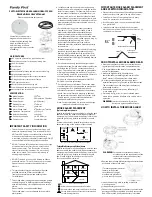
Model AA-940
Two Button Code Learning
Remote Alarm With Starter Inhibit
And Two Stage Shock Sensor
Installation & Operating Manual
What Is Required For This Installation:
1) A working knowledge of automotive mechanical and electrical systems.
2) Electric Drill, 1/8” Drill Bit and (2), # 8 x 3/4” Sheet Metal Screws: To drill the mounting holes and secure
the Siren Assembly to the vehicle.
3) Electrical Tape: For insulating your wiring connections.
4) (4) 6” Cable Ties: For securing the Starter Inhibit Relay and routing the harness under the hood and inside
the vehicle’s underdash area.
Installation Of The Major Components:
Siren:
Mount the Siren/Control Module in the engine compartment. The assembly should not be mounted within
8” of any hot surface. Also consideration should be made to keep the unit away from any moving parts,
such as the steering shaft or knuckle, as this will interfere with safe operation of the vehicle. Use the siren
bracket as a template and mark the two mounting holes with a pencil or scribe. Drill the two holes with a
1/8” drill bit and secure the siren assembly to the location with two #8 screws.
LED Assembly:
Mount the LED assembly inside the vehicle with consideration to maximize visibility from outside the
vehicle while not causing distraction to the operator of the vehicle. The assembly can be mounted using
the double stick tape by peeling the protective backing and placing on a clean flat surface. For mounting
on uneven surface or area’s exposed to direct sunlight where heat may effect the double stick tape, the
screw provided can be used to further secure the LED assembly.
Starter Inhibit Relay:
Mount the starter inhibit relay near the ignition switch harness under the dashboard. You will have to
locate and cut the low current starter wire later in the installation. Secure the relay in a convenient location
with a cable tie or tape to existing harness. Be certain the relay’s wires are accessible for making connec-
tions later during the wiring section of this installation.
Wiring:
RED FUSED WIRE:
+ 12 VDC CONSTANT BATTERY SOURCE
Connect the red fused wire to a + 12 VDC constant battery source capable of supplying 15 amps of current.
This wire provides power to the unit as well as power for the parking light output.
BLACK WIRE:
CHASSIS GROUND
Connect this wire to a solid, metal part of the vehicle’s chassis.
Do not confuse this wire with the thin black antenna wire that exits the control module independently.
YELLOW WIRE:
+ 12 VDC IGNITION SOURCE
Connect this wire to a source that is hot when the key is in the on and crank positions, and off when the key is
in the off position.
WHITE WIRE :
+ 12 VDC PULSED PARKING LIGHT OUTPUT ( 10 AMP MAX )
This wire is provided to flash the vehicle’s parking lights. Connect the white wire to the positive side of one of
the vehicle’s parking lights.
ORANGE:
300 mA GROUND OUTPUT WHEN ARMED - N. C. STARTER DISABLE
This wire is provided to control the starter cut relay. Connect the orange wire to terminal 86 of the relay.
Connect relay terminal 85 to an ignition wire in the vehicle that is live when the key is in the on and crank
positions and off when the key is in the off position. ( This is where the yellow wire from the alarm should be
connected ).
Cut the low current starter solenoid wire in the vehicle and connect one side of the cut wire to relay terminal
87A. Connect the other side of the cut wire to relay terminal 30.
NOTE : This is a normally closed starter cut arrangement and when power is removed from the
security system, the starter disable feature will not operate, allowing the vehicle to start. Audiovox
does not recommend using the Orange wire to interrupt anything but the starting circuit of the ve-
hicle.
TWO PIN RED & BLACK: LED Connector
Route the two wires from the previously mounted LED to the two pin connector of the module.
Operation:
Code Learning:
In case the transmitter is lost, or you require additional transmitters, the code of the transmitter must be
programmed into the receiver before it is capable of responding to the new or additional transmitters. Please
perform the folowing procedure:





















